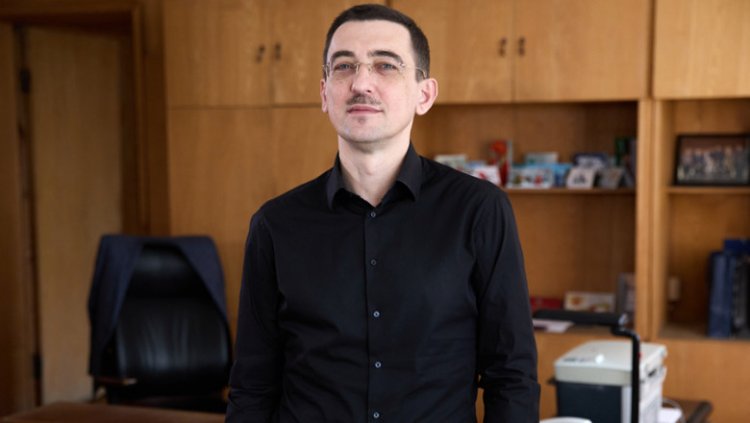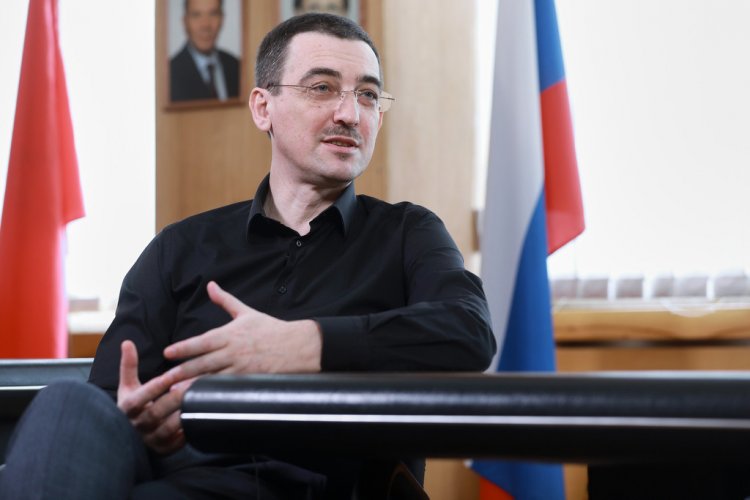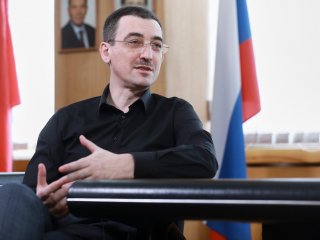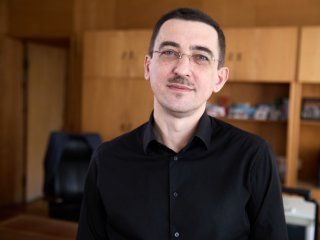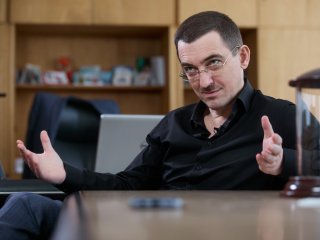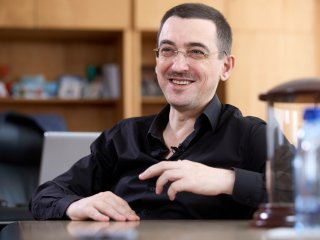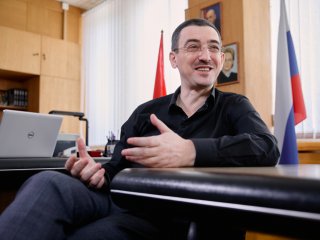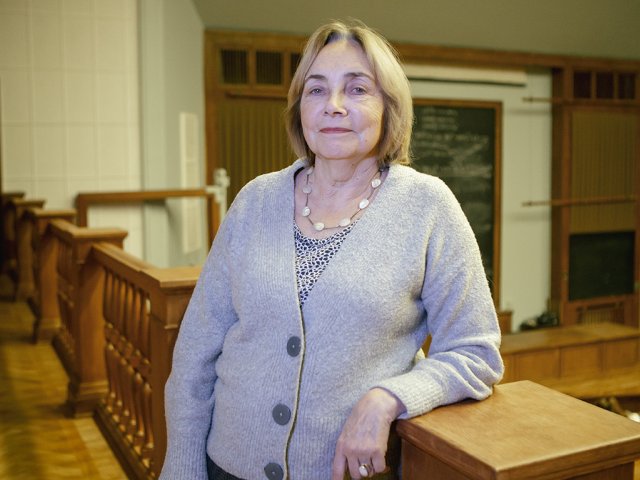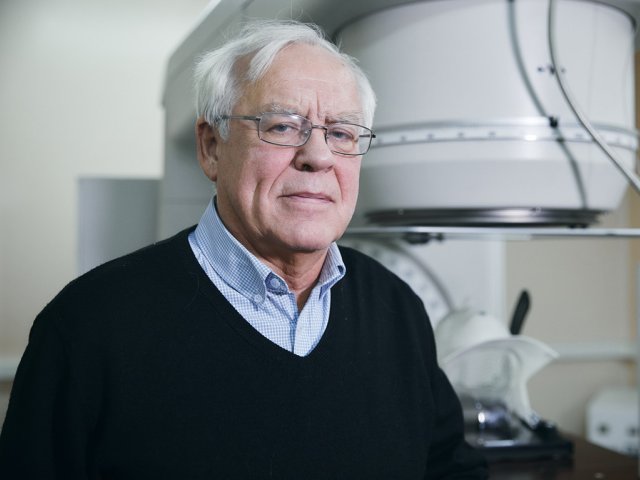The history of nanotechnologies began with the speech of Nobel Prize winner Richard Feynman. In 1959, he read a lecture with an intriguing title – There's Plenty of Room at the Bottom. Feynman stressed that there were no limits for work on molecular and atomic level from the viewpoint of physical laws. In order to work with such tiny objects, it is quite enough to design the respective equipment. In Russia, the terms with prefix nano started being used not so long ago – about 10 years ago, when the country set a course for development of nanoindustry in general. At present, nanotechnologies have become widely used in medicine. These issues among other ones are covered in the interview with academician of the Russian Academy of Sciences Mikhail V. Dubina.
Mikhail Vladimirovich Dubina, academician of the Russian Academy of Sciences, acting director at the State Research Institute of High Purity Biologicals under the Federal Medico-Biological Agency (FMBA) in Saint Petersburg.
Photo: Nikolay Malakhin / Scientific Russia
− How did nanotechnologies come to medicine?
− I would say that they have always been used in healthcare, but nobody called them like that. The matter in question I about nanostructures with the size by 1,000 times lower than micron. Any physician will say that it is the size of common protein – albumin, globulin, as well as ions and small molecules in blood and intercellular fluid.
Your question is a problematic point in modern medicine, especially if we try to give definition to nanotechnologies. First of all, it I related to Richard Feynman and his famous article about plenty room at the bottom. In 1959, he formulated the main idea of nanotechnologies about forming perfect and having no defects entities on atomic level. Since that very moment, the public’s fascination with what is located lower than microcosm has led to the spread of nanotechnologies in various areas of activities including healthcare.
− When and why did the medical community become interested?
− I will begin with the most vivid example related to medications and delivery of active agent. There is an antifungal toxic drug – amphotericin. It kills various fungi well, yet produces toxic effect on kidneys when being used. In 1970s, the US scientist suggested placing the active agent into a drop of fat similar to cellular membrane in composition. In this case, the effective dose could be reduced by 3-4 times thus producing no toxic effect on kidneys. As the size of fat drop was in nanoscale – by about 100 times less than 1 micron – these experiments were perceived as innovative nanotechnologies in medicine. In the modern sense, nanotechnologies in biology have three main features. The first one is the size by 10-100 times less than a micron. The second one I artificial nature. The third feature is controllability.
By the way, viruses are nanotechnological objects created and controlled by nature.
− Speaking about nanotechnologies, people mention the so-called nanomachines. What are they like? How are they used in the context of nanotechnologies in medicine?
− The existing nanomachines, nanorobots, nanolancets, etc. constitute an attempt of mankind to reproduce perfect mechanisms, robotic complexes which ensure the vital functions of cells and the very life in them. Coming back to school curriculum, any ribosome, any peptide synthesis, DNA synthesis are based on continuous work of biological nanomachines. In reliance on this knowledge, we are able to synthesize ten, twenty and even one hundred linear sequences which can twist and create any structure, including movable ones. Nowadays, the scientists whose imagination has no limit try to crate nanocontainers out of such structures where one can place the drugs. This container is introduced into human organism being opened later under the impact of electromagnetic impulse.
− Do you mean protein structures?
− These may be both protein and DNA structures, as well as sometimes fluorescent agents used to illuminate certain areas. Today, the capacity of nanotechnologies is restricted only by the imagination of molecular biologists, specialist in genetic engineering and bioinformatics.
Meanwhile, I reckon such thing among technological toys, though the Nobel Prize is awarded for them. When we talk about the medical application of certain technologies, the question on expediency always arises. Fundamentally, the physicians solve their own problems – surgical, therapeutic, etc. In order to introduce a new solution into medical practice, the physicians should, as minimum, have a profound knowledge in physics to understand how the innovation works and what it can be used for, while physicist and chemists in their turn ought to have medical knowledge. It is clear that both conditions are hardly realistic, and even pointless in the period of unified state exam. If the physician will devote much time to studying physics and chemistry, they will lose medical kills. It creates one more obstacle for the largest-scale integration. The modern interdisciplinary areas need interpreters who are well versed in both areas of research and know how to choose the best of them.
In this connection, the enlightening and educating processes are being upgraded. Today, any student and even school boy/girl interested in some narrow area of expertise may actually be better versed in this issue than a professor. Naturally, the development of Internet promotes it. I know it firsthand. Many of my students are extremely talented people. By the way, an article of one of my talented students-physicists Daniil Stupin has been published. So, I used to ask them: “What do you need me for?” The same question was set by one of the teachers in my student’s years: “You and I study physiology, its complex mechanisms. What makes you different from a distinguished professor or even academician in the field of medicine?” After a pause, he would answer the question himself: “Everything that you will learn during the lecture today is new for you. Believe me, it is also Hebrew to a distinguished physician or professor dealing with physiology or cardiology for the whole of their life. However, they know where to find the required information.” This is the main difference of modern higher education – imparting the knowledge about the sources of required information and dismissing worries about using new and unconventional approaches.
− There are so-called nanolancets in surgery. What kind of area is it? What principle the work of these structures is based on?
− These devices are based on the principle of external physical control over the objects inside the human organism. Nanotechnologies have advantages of their own. First, it is the ability to create different structures with required properties. For instance, they will warm up quickly in required area in response to direct electromagnetic or weak laser effect. Or move inside the organism being exposed to external electromagnetic impact and open up in the required place delivering the dose of medication. The nanolancets are about manipulating cells. The method of cutting is based on the effect produced by electrical or chemical properties of preliminary introduced particles.
− Are such technologies implemented in medical practice?
− Yes, both in Russia and abroad. Generous financing of such projects is the evidence of this area being relevant. Consequently, the projects are being implemented.
− Is there any interest?
− Naturally, there is, as it is fascinating to create new things. The question is whether they have financial support and technological base to implement the ideas.
− How safe are these technologies?
− It is a good question. As is known, the Moon has two sides. The same is true for nanobiotechnologies. While creating and using the drug, we stem from the dosage. In case of nanobiotechnologies, the question is in size. The reduction in the size of nanostructures allows the synthesized objects to penetrate deeper into the body and make it into the places, where they may show absolutely unpredictable properties. It is where the potential danger of nanobiotechnological developments lies. That is why this area required high-quality control.
Mikhail Vladimirovich Dubina
In order to use the benefits of nanobiotechnological developments, including the unobvious ones, they ought to be studied. Here, the methods of crystallography, genomic and proteomic analysis, atomic force microscopy and electronic microscopy are used. I.e., a sort of system is required.
Switching over to a lower level and increasing specific surface, we create opportunities for unpredictable reactions, including biological ones. At the same time, we see some reckless implementation of nanotechnological developments, as they are commercially effective.
As always, we will meet with the consequences of such an approach many years later. Say, we have gambled on hydrocarbon economy before, and are now combatting the greenhouse effect; used the benefits of nuclear energy, and are now trying to combat radioactive wastes. Such examples are many.
− As far as nanotechnologies are concerned, what may their consequences be?
− Various ones. To my mind for instance, COVID-19 pandemic is one of the consequences as to the lack of control in the field of nanotoxicity. Much has been said about the coronavirus having special thorns. They are intrinsic to virtually all viruses. Asa result of genetic mutations, these thorns started coming closer to receptors, which turned out to be fatal for the mankind. The point is that these thorns generated smaller thorns, which changed the specific surface and configuration of virus. Put it simply, a small additional knobble has randomly run in with the cavity on the receptor. It has made the virus pathogenic. What do nanostructures have to do with it? The fact is that additional thorns consist of four amino acids, i.e., their size is about five nanometers.
− It is a random process at core, right?
− Yes, a random one. But the question is how fast we bring such chance events nearer.
The things we are trying to make – walking nanorobots, nanolancets, nanodrugs, nanocontainers, etc. – represent kids’ toys if compared to the very life continuously creates. Just imagine, each of us consists of about 30 trillion cells and 50 trillion bacteria, and 70 billion intestinal cells alone die daily. It is a sort of ongoing update which takes place thanks to our internal mechanisms of self-assembly and self-destruction which have been formed over many million years of evolution. These processes are well-tuned and conservative. They are reproducible and observable. However, we know little about it so far.
Pursuing our subject, I should say that viruses are nanomachines of natural origin. Till the virus is in the extracellular environment or in the process of infecting the cell, it exists in the form of independent particle. They consist of two main components: genetic material in the form of DNA or RNA and protein coat (capsid) protecting these molecules. The viruses take advantage of the master cell’s resources for creating many copies of them, while their assembly takes place inside the cell. To do that, the virus has to deliver its genetic material inside the cell. Actively reproducing virus not always kills the master cell. HIV, for instance, builds into the DNA of immune cells and makes their functions weaker. The virus disengages from the cell by way of budding and provides itself with its own coating, which represents a modified fragment of master cell’s membrane. It is an extremely complicated nanobiotechnological complex of self-reproduction which interacts with the cell and uses it for creating its copies.
− The knowledge of these complex processes allows for creating vaccines, doesn’t it?
− Sure. Vaccines are one of the greatest achievements of mankind. However, I admire the nature, its diversity and processes, which sometimes are very complex. This admiration generates enthusiasm in trying to conceive its mysteries and use them for the benefit of mankind. The vaccine is a method to activate and intensify natural mechanisms of immune protection that the nature has created in human organism.
− Tell me, please, about the Institute of High Purity Biologicals. What areas of research does it develop?
− The State Research Institute of High Purity Biologicals was founded for production of new recombinant preparations. The point is in creating a biosimilar of active molecules or synthetic drugs with the help of genetic structures. Initially, the Institute was envisioned to be a fully integrated establishment dealing with development, laboratory synthesis, preclinical trials, test output and mass production of drugs. Since 2020, it has been working under the standard of pharmaceutical production GMP. One of the products issued today is erythropoietin alpha which is used for stimulation of hematopoiesis in cases of renal insufficiency, oncological and other diseases. At present, this medication is on the list of essential drugs. The Institute has been producing it for over 15 years.
The Institute has convoluted history which repeats our country’s one to some extent. It is very important that our institution has still been preserved. At present, it can be perceived as a state company for study, development and production of pharmaceuticals from the idea to manufacture.
Today, we struggle for existence in order to develop further, create and implement medications for saving the lives of our citizens and support of Russia’s biosecurity.
− An extremely relevant topic.
− You are quite right. Yet, the existence of any institution in commercial environment depends upon financing in the first turn.
− How can the problems that the Institute faces be solved?
− It is to be recalled that the Institute’s legal form (since 2006) is the federal state unitary (not budgetary) enterprise. The budgetary form does not envision the production element. The situation is more challenging, as a new variant of state strategy Pharma-2030 includes only budgetary organizations. It means that we cannot take advantage of these support measures, while business does not need a state player that disturbs the competition.
− A vicious circle, isn’t it?
− Sure. I think that this problem ought to be solved at the expense of state support. WE work actively suggesting the variants of our own.
− What are you working now on? Do you have time for research?
− It is a challenging question. Naturally, the greater part of my life is related to saving the unique and legendary institution which, I am sure, can be considered an important component of Russia’s biosecurity. The Institute is a battleship partially damaged, yet carrying serious potential on board. It should certainly be saved. This is what I deal with today.
The research has really taken backseat. Yet, my talented former students whom I remain in touch with come to my rescue. They turn to me for advice, and I am happy to become self-fulfilled in their achievements. I even feel pleased.
− What piece of advice would you give to young scientists who are at the start of their way of nanotechnologies in medicine?
− I was lucky to work both at a medical higher educational establishment and physics institution under the guidance of Novel Prize winner Jaures Alfyorov. At that time, we faced the task of marrying physics and medicine to achieve a happy union. Jaures Alfyorov believed that physics had already discovered all laws of the universe, so we were to look for their application for the benefit of mankind – in medicine in the first turn.
I have worked with physicists, physicians and chemists. Over the past years, I have fully realized that the role of coach lies in lighting the fuse instead of filling the vessel with knowledge. If there is no fuse, one has nothing to light.
The main thing is glint in the eyes, not the way you choose.
Interview taken with the support of the Science and Higher Education Ministry and Russian Academy of Sciences
